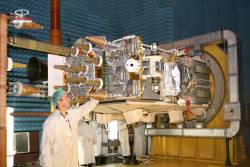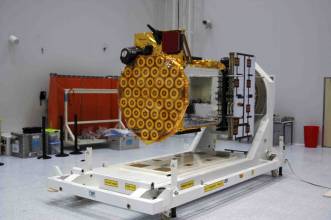 GLONASS-K1 at ISS-Reshetnev
GLONASS-K1 at ISS-ReshetnevRussia launched the second and final GLONASS-K1 flight-test satellite on Sunday (November 30, 2014) from the Plesetsk cosmodrome on board a Soyuz 2-1B rocket.
Built by ISS-Reshetnev, the satellite broadcasts five navigation signals in three frequency bands – L1, L2 and L3. A civil CDMA signal is among those to be transmitted in the L3 band. The spacecraft also carries new equipment to support the international search and rescue system COSPAS-SARSAT: a payload that can relay signals from users in distress.
Russia launched the second and final GLONASS-K1 flight-test satellite on Sunday (November 30, 2014) from the Plesetsk cosmodrome on board a Soyuz 2-1B rocket.
Built by ISS-Reshetnev, the satellite broadcasts five navigation signals in three frequency bands – L1, L2 and L3. A civil CDMA signal is among those to be transmitted in the L3 band. The spacecraft also carries new equipment to support the international search and rescue system COSPAS-SARSAT: a payload that can relay signals from users in distress.
The spacecraft is based on ISS-Reshetnev’s Express-1000K satellite platform and has an expected mission life of at least 10 years.
The first GLONASS-K1 was sent into orbit on February 26, 2011, but launch of this second spacecraft experienced a series of technical delays. With a reduced weight of 935 kilograms (2,057 pounds) compared to the GLONASS-M’s 1415 kilograms (3,113 pounds), future GLONASS-K2 launches may carry two satellites at a time.




